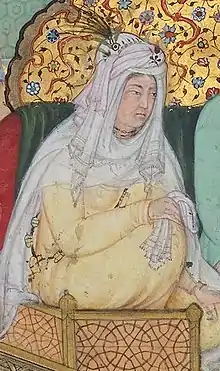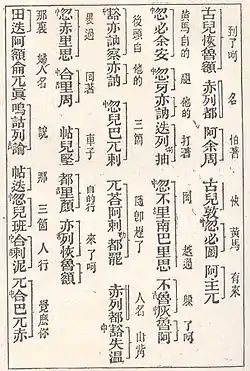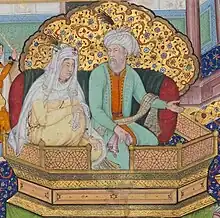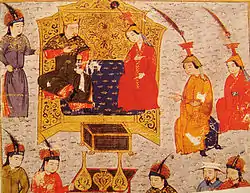Börte
Börte (simply Börte, also Börte Üjin; Mongolian: ᠪᠥᠷᠲᠡ ᠦᠵᠢᠨ; Cyrillic: Бөртэ үжин; c. 1161–1230) was the first wife of Temüjin, who became Genghis Khan, the founder of the Mongol Empire. Börte became the head of the first Court of Genghis Khan, and Grand Empress of his Empire. Little is known about the details of her early life, but she was betrothed to Genghis at a young age, married at seventeen, and then kidnapped by a rival tribe. Her husband's daring rescue of her may have been one of the key events that started him on his path to becoming a conqueror. She gave birth to four sons and five daughters, who, along with their own descendants, were the key bloodline that further expanded the Mongol Empire.
| Börte Khatun | |||||
|---|---|---|---|---|---|
 Detail of a Mughal miniature painting showing Börte. | |||||
| Great Khatun of the Mongol Empire and Khamag Mongol | |||||
| Tenure | 1189–1230 | ||||
| Successor | Toregene | ||||
| Born | 1161 Khamag Mongol (now Khentii, Mongolia) | ||||
| Died | 1230 (aged 68–69) Mongol Empire (now Avarga, Mongolia) | ||||
| Burial | |||||
| Spouse | Genghis Khan | ||||
| Issue | Jochi Chagatai Ögedei Tolui Khochen Bekhi Alakhai Bekhi Tümelün Altalun Checheikhen | ||||
| |||||
| House | Onggirat | ||||
| Father | Dei Seichen | ||||
| Mother | Tacchotan | ||||
| Religion | Tengrism | ||||
Börte and Hoelun, Genghis' mother, were some of the most influential and important people in the Khan's life.
Early life

Few historical facts are known about her early life, but Mongolians have many legends about her. What little is known is generally from The Secret History of the Mongols.
Börte was born around 1161 into the Olkhonud of Khongirad. This tribe was friendly to the Borjigin tribe, into which Temüjin was born. She was the daughter of Dei-Sechen and Chotan. She was described as having a "fair complexion" with "light in her face and fire in her eyes," meaning that she was intelligent. The girls that came from the Olkhonud tribe were known for being particularly beautiful.[2][3]
Marriage

Börte was the first wife of Temüjin. When Temüjin was nine years old his father, Yesügei, went in search of a wife for him. He set out to find a girl of Temüjin’s mother’s people, the Olqunu’ut, but along the way ran into Dei-Sechen, Börte’s father. Dei-Sechen explained he had a dream the previous night about Yesügei arriving with his son and believed this was a good omen.[4] He described that the women of his people, the Onggirat, were known for having beautiful girls and stated that his daughter Börte, who was ten, would make a good wife for Temüjin. Upon meeting Börte, Yesügei described her as a girl “Who had light in her face, who had fire in her eyes” and after spending the night asked Dei-Sechen for Börte’s hand in marriage for his son.[5] Dei-Sechen agreed under the condition that Temüjin stay with Börte’s family as his bride price. Unfortunately, on his return from this trip, Yesügei encountered some Tatars having a feast and decided to join them whereby they poisoned his food. He completed his journey back home before collapsing and ultimately passing away.[6] Before he died, however, Yesügei insisted Temüjin be called back home to take care of his siblings in the absence of their father. Dei-Sechen agreed to allow Temüjin to return to his family and so Börte and Temüjin were separated quickly after their betrothal.
In 1178, after seven years apart, Temüjin set out to be reunited with Börte. After finding her in the same village in which she lived before, the two were married and left for a new home on the Senggür Stream located in the Gürelgü Mountains. Soon after, they moved to set up a new homestead on the Burgi Escarpment near the Keuren River. Here, Börte’s dowry, a black sable coat, was gifted to Yesügei’s old friend Ong Qan reestablishing a friendship between the two families.[7]
Abduction
Soon after her marriage to Temüjin was made official, the Burgi Escarpment was attacked by the Three Merkit, or Mergeds, who were a confederation of three tribes, inhabiting the basin of the Selenga and Orkhon Rivers. Temüjin and his family were able to escape on horses, but there were no horses left for Börte. A servant at the camp tried to hide Börte in an old cart, which he harnessed to an ox to try to escape upstream with her. The cart eventually broke and when the servant tried to keep moving Börte on foot, they were surrounded by soldiers who discovered her within the cart.[8] The Three Merkit believed their raid victorious as they had planned it in retaliation for the abduction of Hoelun, Temüjin’s mother, from their people many years before.
Temüjin was deeply distressed by the abduction of his wife and remarked that his bed "was made empty" and his breast was "torn apart".[3] Ong Qan, who had been gifted Börte’s dowry, promised to help Temüjin recover Börte from the Three Merkit, and together they came up with a plan to return her.[9] Eight months later the pair led a charge to the Barqujin territory, and upon their arrival the Merkit people fled in numbers down the Selengge River. Börte and Temüjin were finally reunited as described in The Secret History of the Mongols:
As the pillaging and plundering went on, Temüjin moved among the people that were hurriedly escaping, calling, 'Börte, Börte!' And so he came upon her, for Lady Börte was among those fleeing people. She heard the voice of Temüjin and, recognizing it, she got off the cart and came running towards him. Although it was still night, Lady Börte and Qo'aqčin both recognized Temüjin's reins and tether and grabbed them. It was moonlight; he looked at them, recognized Lady Börte, and they fell into each other's arms.[3]
Later, Khan would go on to exterminate the Merkit people and enslave their women.[10]
Ruling
Börte brought more than just a marriage to Temüjin. She brought with her independent wealth, based on her dowry, and a shrewd and intelligent mind. Börte shared some responsibilities with her mother-in-law Hö’elün, including the management of human and animal resources and the economy of the camp overall.[11]
Around 1179, the first of Börte’s children, Qojin, was born. Börte’s nine children were ultimately another resource that she provided Temüjin; her five daughters would go on to marry key political allies to cement diplomatic relationships, while her four sons were quite influential in Temüjin’s conquests throughout Asia.[12]
Additionally, she also managed pan-Asian trade routes and acted as advisors to officials and merchants traveling these roads.[10] She maintained considerable power in this position, and there are multiple documented events in which she exercised this power. For example, she had successfully advised Temüjin to cut ties with Jamqua, a military leader, when she had deemed that the alliance was no longer mutually beneficial. Additionally, she insisted that a shaman, Teb Tenggeri, should be challenged for his insolence, as he was acting in an insulting manner towards Temüjin’s family. Both of these requests were dutifully followed by Temüjin.
As she was the first wife of Temüjin, she was the most influential. She was revered by the Mongols after he became Genghis Khan, and she was crowned the Grand Empress.
Börte on several occasions heavily influenced her husband's decisions. One such occasion was when Otčigin came into Genghis Khan's tent while he was still in bed with Börte, and asked for help against the Qongqotan tribe. Before Genghis Khan could say anything, Börte "sat up in bed, covering her breasts with the edge of the blanket" and described the cruelty of the Qongqotan. After listening to his wife speak, Genghis Khan decided to help Otčigin. There is also evidence of Börte influencing how strict Khan was with members of his cabinet. In one instance, Börte told Khan to separate from friend Jamqua after the alliance went bad, in order to maintain his authority within the court.[10] On another instance Börte insisted shaman Teb Tenggeri should be challenged for his insolence and resultantly his back was broken for insulting Khan’s youngest brother Temuge Otchigin.[10] Khan both respected and appreciated Börte’s insight on political relationships.
As Genghis Khan continued to expand his influence and empire, Börte remained behind and assisted Genghis' brother Temüge in ruling the Mongol homeland. Other wives accompanied Genghis Khan on his campaigns, while she ruled her own territory and managed her own court. Most of the Kherlen River was assigned to her, land that had before belonged to the Tatars. Only her sons were considered to be candidates to succeed Temüjin as Khans. While doing so, she also adopted multiple orphans, including Qutqu Noyan and Buda Noyan, and raised them as her own - greatly improving her reputation and social status as a mother.[10]
Family
Börte's sons:
Daughters:
- Kua Ujin Bekhi, the eldest, was betrothed to Tusakha, son of Senggum, and grandson of Wang Khan, ruler of the Keraite tribe; she eventually married Botu, of the Ikires tribe, and widower of her paternal aunt Temulun.
- Alakhai Bekhi, married first to Alaqush Digit Quri, chieftain of the Ongüt tribe; then to his nephew and heir Jingue; and finally to her stepson Boyaohe
- Tümelün, married to Chigu, son of Alchi, son of Dei Seichen, Börte's father
- Alaltun married Chaur Setsen, son of Taiju Kurgen of the Olkanut tribe.[13] She is often confused with Il-Alti, a daughter by a concubine, who was given to the Uyghur chieftain Idi Qut.[13]
- Checheikhen, married to Törölchi, son of Quduka beki, of the Oirat tribe.
Börte and Temüjin placed great faith (and territory) into their children, also supplying them with considerable wealth and positions to inherit. There was some family conflict over succession; there were doubts about the true father of Jochi, as it is feasible that Börte was raped during her kidnapping and, therefore, that Jochi’s father may be one of her captors.[10] Chagatai, Jochi’s brother, often chided Jochi for these claims, which often led to quarrels between the two brothers. Temüjin reportedly wholeheartedly denied this accusation, calling them disrespectful and claiming Jochi as his son.[10] As a result of this infighting, Ghengis Khan opted for neither Jochi nor Chagatai to take over his legacy as Khan. Instead, Ogodei was selected to rule because he was a peacemaker between his two brothers.[10] Ogodei and Tolui took the reins of their parents’ legacies and their children continued to rule as Khan in many later generations. Both Jochi and Chagatai would also go on to become rulers of territorial divisions, although not the entire empire. Jochi’s descendants, for example, would found and rule over the Golden Horde in the west.[10]
Legacy and modern representations
Börte died in 1230 before her husband passed away.[14] Ultimately, throughout her life, Börte earned a reputation of reverence and respect from the Mongol people.[10] She was a highly admired mother figure for the whole empire, an image which was bolstered by her relationships with both her biological and adopted children. She also deftly cultivated political marriages for her daughters, solidifying relations politically.[15] Throughout history, the Onggiard would use political marriages to ensure friendly relations between the parties involved, with the daughters acting as “intercessors.” In this manner, Börte acted as an advisor to both her husband as well trained her daughters to believe in their mission as “representatives, diplomats, and active participants in affairs of state.”[15]
Given her significant role in Genghis Khan's life, Börte has appeared as a prominent character in the many films and television series based on her husband's life and conquests. The actresses who have portrayed her include Susan Hayward in The Conqueror, Françoise Dorléac in Genghis Khan and Chuluuny Khulan in the 2007 Oscar nominated Russian film Mongol.[16] She has also appeared as a playable character in the video game Iron Maiden: Legacy of the Beast, created by the popular metal band of the same name.[17]
References
- Lee, Lily Xiao Hong; Wiles, Sue (2014). Biographical Dictionary of Chinese Women: Tang Through Ming, 618-1644. M.E. Sharpe. p. 12. ISBN 9780765643162.
- Onon 2005, sections 65–66.
- Rachewiltz, Igor de (December 2015). "The Secret History of the Mongols: A Mongolian Epic Chronicle of the Thirteenth Century". Western Washington University.
- de Rachewiltz 2006, pp. 13–14.
- de Rachewiltz 2006, p. 15.
- de Rachewiltz 2006, p. 16.
- de Rachewiltz 2006, p. 29.
- de Rachewiltz 2006, p. 31.
- de Rachewiltz 2006, p. 34.
- May, Timothy Michael (7 November 2016). The Mongol empire : a historical encyclopedia. ABC-CLIO, an imprint of ABC-CLIO, LLC. p. 135. ISBN 978-1-61069-339-4. OCLC 1030610485.
- Broadbridge, Anne F. (2018-07-10). Women and the Making of the Mongol Empire. Cambridge University Press. p. 57. doi:10.1017/9781108347990. ISBN 978-1-108-34799-0. S2CID 165687035.
- Broadbridge, Anne F. (2018-07-10). Women and the Making of the Mongol Empire. Cambridge University Press. p. 61. doi:10.1017/9781108347990. ISBN 978-1-108-34799-0. S2CID 165687035.
- Ad-din, Rashid. Jami Al Tawarikh (Compendium of Chronicles).
- Buell, Paul D. 1941- (2018). Historical dictionary of the Mongol world empire. Rowman & Littlefield. p. 124. ISBN 978-1-5381-1136-9. OCLC 1032304968.
- May, Timothy Michael (7 November 2016). The Mongol empire : a historical encyclopedia. ABC-CLIO, an imprint of ABC-CLIO, LLC. p. 134. ISBN 978-1-61069-339-4. OCLC 1030610485.
- Mongol: The Rise of Genghis Khan, 20 September 2007, retrieved 2019-07-26
- "Iron Maiden Twitter". Twitter. Retrieved 2023-05-04.
Sources
- René Grousset. Conqueror of the World: The Life of Chingis-khan (New York: The Viking Press, 1944) ISBN 0-670-00343-3.
- Ratchnevsky, Paul (1991). Genghis Khan: His Life and Legacy. Blackwell Publishing. ISBN 0-631-16785-4.
- Man, John. Genghis Khan: Life, Death and Resurrection (London; New York : Bantam Press, 2004) ISBN 0-593-05044-4.
- Onon, Urgunge, ed. (2005). The secret history of the Mongols; The life and times of Chinggis Khan (Chapter 2) (PDF). Taylor & Francis. ISBN 0-203-98876-0.
- de Rachewiltz, Igor (2006). The secret history of the Mongols : a Mongolian epic chronicle of the thirteenth century. Leiden. ISBN 90-04-15363-2. OCLC 173262183.
{{cite book}}: CS1 maint: location missing publisher (link) - Weatherford, Jack (2010). The Secret History of the Mongol Queens. Broadway Paperbacks, New York. ISBN 978-0-307-40716-0
- Broadbridge, Anne (2018). Women and the Making of the Mongol Empire. Cambridge University Press. ISBN 978-1-108-34799-0
- May, Timothy (2016). The Mongol Empire: A Historical Encyclopedia. ABC-CLIO. ISBN 978-1-610-69339-4
